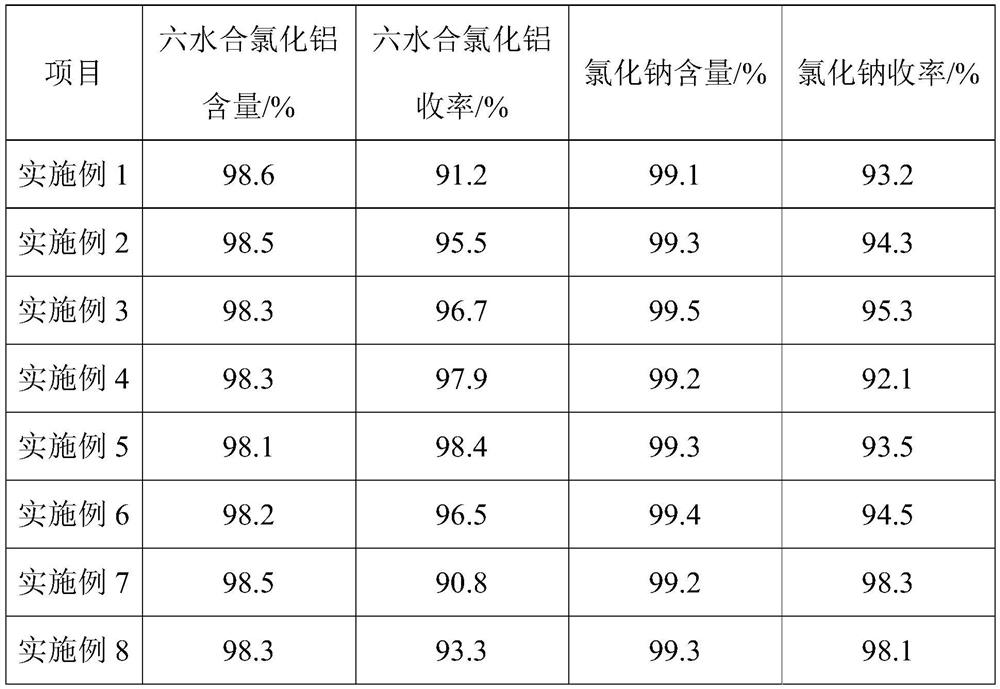Treatment method of sodium tetrachloroaluminate solid residues
A technology of sodium tetrachloroaluminate and a treatment method, applied in the field of inorganic chemistry, can solve problems such as high cost, complicated process, difficult separation, etc., and achieve the effects of simple operation, simple process flow and cost reduction
- Summary
- Abstract
- Description
- Claims
- Application Information
AI Technical Summary
Problems solved by technology
Method used
Image
Examples
Embodiment 1
[0052] This embodiment provides a method for treating sodium tetrachloroaluminate solid slag. The sodium tetrachloroaluminate solid slag is derived from preparing methyl chloride, phosphorus trichloride, aluminum powder and aluminum trichloride as main raw materials. In the production process of base phosphine dichloride, the content of sodium tetrachloroaluminate in the solid slag is 95%, and the treatment method comprises the following steps:
[0053] (1) 100g of solid slag with a sodium tetrachloroaluminate content of 95% is added to 400g of water for dissociation, dissociated for 1h at 80°C, and then 70g of hydrogen chloride gas is introduced, that is, the mass ratio of solid slag and hydrogen chloride is 1: 0.7, there is aluminum chloride hexahydrate to separate out, then through a solid-liquid separation to obtain aluminum chloride hexahydrate solid and a filtrate;
[0054] Among them, 121.5g of aluminum chloride hexahydrate solid was obtained by one solid-liquid separat...
Embodiment 2
[0057] The present embodiment provides a method for treating the solid slag of sodium tetrachloroaluminate, and the solid slag of sodium tetrachloroaluminate is the same as that in Embodiment 1, and the treatment method includes the following steps:
[0058] (1) 100g of solid slag with a sodium tetrachloroaluminate content of 95% is added to 400g of water for dissociation, dissociated at 80 ° C for 1h, and then 100g of hydrogen chloride gas is introduced, that is, the mass ratio of solid slag and hydrogen chloride is 1: 1.0, there is aluminum chloride hexahydrate to separate out, then through a solid-liquid separation to obtain aluminum chloride hexahydrate solid and a filtrate;
[0059] Among them, 127.6g of aluminum chloride hexahydrate solid was obtained by one solid-liquid separation, which was dried by vacuum drying at 60 °C for 8 hours to obtain 116.0g of aluminum chloride hexahydrate product;
[0060] (2) the primary filtrate obtained in step (1) is concentrated and cry...
Embodiment 3
[0062] The present embodiment provides a method for treating the solid slag of sodium tetrachloroaluminate, and the solid slag of sodium tetrachloroaluminate is the same as that in Embodiment 1, and the treatment method includes the following steps:
[0063] (1) 100g of solid slag with a sodium tetrachloroaluminate content of 95% is added to 400g of water for dissociation, dissociated at 80 ° C for 1h, and then 150g of hydrogen chloride gas is introduced, that is, the mass ratio of solid slag and hydrogen chloride is 1: 1.5, there is aluminum chloride hexahydrate to separate out, then through a solid-liquid separation to obtain aluminum chloride hexahydrate solid and a filtrate;
[0064] Among them, 131.1g of aluminum chloride hexahydrate solid was obtained by one solid-liquid separation, which was dried by vacuum drying at 60 ° C for 8 hours to obtain 117.6g of aluminum chloride hexahydrate product;
[0065] (2) the primary filtrate obtained by step (1) is concentrated and cr...
PUM
 Login to View More
Login to View More Abstract
Description
Claims
Application Information
 Login to View More
Login to View More - R&D
- Intellectual Property
- Life Sciences
- Materials
- Tech Scout
- Unparalleled Data Quality
- Higher Quality Content
- 60% Fewer Hallucinations
Browse by: Latest US Patents, China's latest patents, Technical Efficacy Thesaurus, Application Domain, Technology Topic, Popular Technical Reports.
© 2025 PatSnap. All rights reserved.Legal|Privacy policy|Modern Slavery Act Transparency Statement|Sitemap|About US| Contact US: help@patsnap.com


